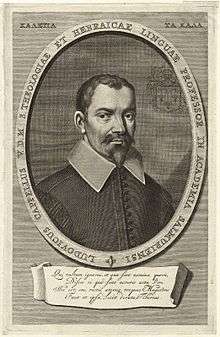Louis Cappel
Louis Cappel (15 October 1585 – 18 June 1658) was a French Protestant churchman and scholar.
Louis Cappel | |
|---|---|
 | |
| Born | 15 October 1585 St Elier, near Sedan, France |
| Died | 18 June 1658 (aged 72) |
| Occupation | French churchman |
Life
Cappel, a Huguenot, was born at St Elier, near Sedan. He studied theology at the Academy of Sedan and the Academy of Saumur, and Arabic at the University of Oxford, where he spent two years. At the age of twenty-eight he accepted the chair of Hebrew at Saumur, and twenty years later was appointed professor of theology. Amongst his fellow lecturers were Moses Amyraut and Josué de la Place.
Works
As a Hebrew scholar he made a special study of the history of the Hebrew text, which led him to the conclusion that the vowel points and accents are not an original part of the Hebrew language, but had been inserted by the Massorete Jews of Tiberias, no earlier than the 5th century; he also concluded that the primitive Hebrew characters are those now known as the Samaritan, while the square characters are Aramaic and were substituted for the more ancient at the time of the captivity. These conclusions, published anonymously in his book Arcanum punctuationis revelatum (Leiden, 1624), were hotly contested by Johannes Buxtorf II, since they conflicted with those of his father, Johannes Buxtorf senior; Elias Levita had already disputed the antiquity of the vowel points, with which neither Jerome nor the Talmud showed any acquaintance. Eighteenth-century theologian John Gill in his writing, A Dissertation Concerning the Antiquity of the Hebrew Language, Letters, Vowel-Points and Accents,[1] disputed the idea that the vowel points were invented by the Masorites, and claimed that Hebrew authorities removed the vowel points because of their rejection of Jesus as the Messiah.[2] Gill shows that the name Jehovah is documented from before 200 B.C. throughout the centuries of Jewish Authorities, the early Church and the following millennium.[1] He argued that throughout this history the Masorites did not invent the vowel points and accents, but that they were delivered to Moses by God at Sinai, citing Karaite authorities[3] Mordechai ben Nisan Kukizov (1699) and his associates, who stated that "all our wise men with one mouth affirm and profess that the whole law was pointed and accented, as it came out of the hands of Moses, the man of God,"[3][4][5] The argument of the Karaites shows that some copies have always been pointed and some copies were not pointed with the vowels, especially those copies in Synagogues which Gill talks about.[6] Gill claims that various early sources support the pronunciation of Jehovah, including:[1][7]
- Saadiah Gaon - 927 AD [8]
- Jerome - 380 AD [9]
- Origen - 250 AD [10]
- Zohar - 120 AD [11]
- Josephus - 70 AD [12]
- Demetrius Phalereus, librarian for Ptolemy II Philadelphus king of Egypt- 277 BC[13]
Cappel's understanding was proved through the discovery of the Dead Sea Scrolls, where the Hebrew did not include vowel points.
Cappel's second important work, Critica sacra, went further, and was controversial from a theological point of view; having dismissed the antiquity of the vowel points, he now held, based on the various readings in the text and the differences between the ancient versions and the Masoretic text, that the consonantal text of the Hebrew Bible was susceptible to change, corruption, and human interference, which amounted to an attack on the verbal inspiration of Scripture. He had completed the book in 1634, but fierce opposition prevented him from printing it at Paris until 1650, in which he was aided by Jean Morin, who was enthusiastic about the book and agreed with its conclusions.[14] Bitter as was the opposition to Cappel's views, it was not long before his results were accepted by most scholars.
Cappel was also the author of Annotationes et commentarii in Vetus Testamentum and other biblical works, as well as of several other treatises on Hebrew, among which are the Diatribe de veris et antiquis Ebraeorum literis (1645). His Commentarius de Capellorum gente, giving an account of the Cappel family to which he belonged, was published by his nephew James Cappel (1639–1722), who, at the age of eighteen, became professor of Hebrew at Saumur, but, on the revocation of the edict of Nantes, fled to England.
References
- Gill, J. (1778). A Collection of Sermons and Tracts ...: To which are Prefixed, Memoirs of the Life, Writing, and Character of the Author. 3. G. Keith. p. 429. Retrieved 2014-10-25.
- G.A. Riplinger, In Awe of Thy Word, chapter 11
- (In Awe of Thy Word, G.A. Riplinger-Chapter 11, page 422-435),A Dissertation Concerning the Antiquity of the Hebrew Language, Letters, Vowel-Points, and Accents, by John Gill, p. 540 Online
- "Awe 11". scribd.com. Retrieved 2014-10-25.
- "Who is Yahweh? - Ridiculous KJV Bible Corrections". av1611.com. Retrieved 2014-10-25.
- A Dissertation Concerning the Antiquity of the Hebrew Language, John Gill, pp. 548-560
- Gill, John (1697–1771). "A Dissertation Concerning the Antiquity of the Hebrew Language, Letters, Vowel-Points and Accents".
- A Dissertation Concerning the Antiquity of the Hebrew Language, John Gill, p. 501
- A Dissertation Concerning the Antiquity of the Hebrew Language, John Gill, pp. 512-516
- A Dissertation Concerning the Antiquity of the Hebrew Language, John Gill, p. 522
- A Dissertation Concerning the Antiquity of the Hebrew Language, John Gill, p. 531
- A Dissertation Concerning the Antiquity of the Hebrew Language, John Gill, p. 533
- A Dissertation Concerning the Antiquity of the Hebrew Language, John Gill, p. 544
- Michael C. Legaspi, Reviving the Dead Letter: Johann David Michaelis and the Quest for Hebrew Antiquity (Oxford University Press, 2010), ch. 1.
